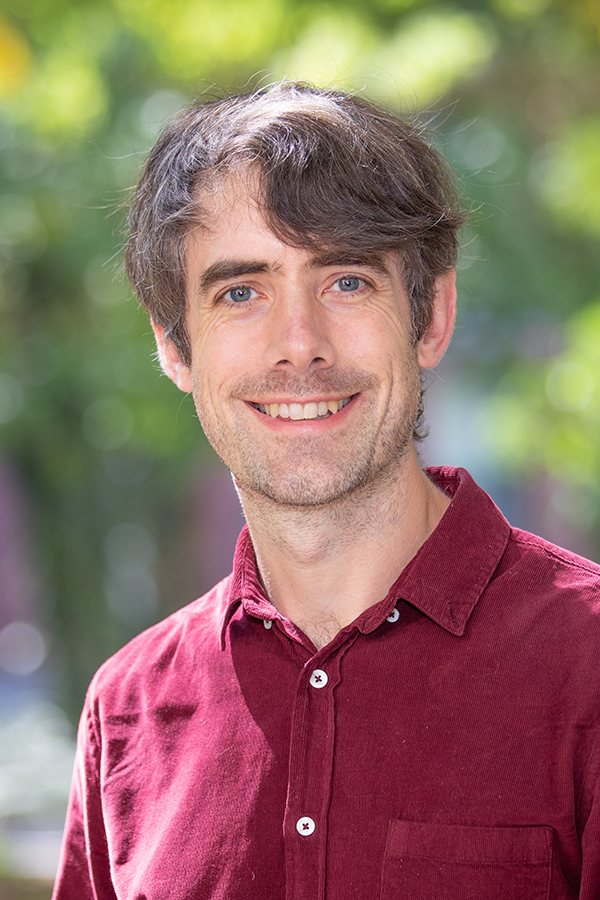News
A giant of a moon appears before a giant of a planet undergoing seasonal changes in this natural color view of Titan and Saturn from NASA's Cassini spacecraft. Image courtesy of NASA/JPL-Caltech/Space Science Institute.
In late November, NASA’s Juno spacecraft was orbiting Jupiter, making atmospheric measurements, mapping the gas giant’s magnetic field, and exploring the planet’s mysterious northern and southern lights.
Meanwhile, here on Earth, undergraduates at the Harvard John A. Paulson School of Engineering and Applied Sciences were drawing up plans for future cosmic explorations. For their final projects in the new course Space Science and Engineering (ES 160), students are challenged to design robotic missions into space.
The course, taught by Robin Wordsworth, Assistant Professor of Environmental Science and Engineering, focuses on the motivations for robotic space missions and the key engineering challenges faced by mission planners. The Juno mission, for instance, posed many obstacles for NASA engineers because it traveled farther from the sun than any solar-powered spacecraft (their solution involved super-efficient solar panels that were arranged to always face the sun).
This illustration depicts NASA's Juno spacecraft at Jupiter, with its solar arrays and main antenna pointed toward the distant sun and Earth. Image courtesy of NASA/JPL-Caltech.
Overcoming such formidable challenges makes space exploration uniquely complex, so course material in ES 160 draws on a number of different areas, including atmospheric and planetary science, remote sensing, and thermal and power management.
“I think that initially the students find the final projects very daunting, but they develop intuition and get a sense for how the important pieces of the field come together and how to play back and forth between different constraints,” Wordsworth said.
Wordsworth established parameters for the mass and volume of the satellites students designed, but left most other elements of their projects up to them, from the justification of the mission to the arrangement of instrumentation.
Student teams planned missions aimed at mapping the Moon’s magnetic field, searching for lodes of precious metals on near-earth asteroids, and monitoring the decline in Earth’s rainforests.
Omar Embaby, S.B. ’18, a mechanical engineering concentrator, and his team set their sights on Titan, the largest moon of Saturn, in the hopes of mapping the molecular species in its atmosphere. Because this moon shows striking similarities to early Earth, mapping molecular species at different altitudes could give scientists insights into the development of life on our planet, Embaby explained.
Mechanical engineering concentrator Omar Embaby, S.B. ’18, explains the justifications for his team's proposed mission to Titan. Photo by Adam Zewe/SEAS Communications.
“Learning about Hohmann transfer orbits and rocket equations was my favorite part of the course,” he said. “People often use the term ‘it’s not rocket science,’ but little do they know that the basics of rocket science are actually very straightforward.”
For their project, astrophysics concentrator Danielle Frostig, A.B. ’18, and her team decided to stay closer to home (within 25,000 miles of Earth, that is) by targeting near-Earth asteroids. They proposed a mission to search asteroids for complex organic molecules, such as methyl cyanide, which are key to the origins of life. Devising a plan for landing proved to be a major challenge, since size, composition, and speeds vary greatly among asteroids.
“The most surprising thing for me was how complicated these types of space missions are, but at the same time how close you can get to the right answer with approximations,” she said. “I really appreciated seeing practical applications of some of my theoretical knowledge. The course bridged a gap for me between far-away astronomy and laboratory engineering.”
This image, taken by NASA's Near Earth Asteroid Rendezvous mission in 2000, shows a close-up view of Eros, an asteroid with an orbit that takes it somewhat close to Earth. Photo courtesy of NASA/JHUAPUL.
When the course was launched in fall of 2015, seven students enrolled; this past fall, enrollment increased to 27. Wordsworth attributes much of that growth to the compelling nature of the subject matter, and renewed focus on space missions fueled by NASA and private companies like SpaceX.
In its next iteration, which will be offered in 2018, Wordsworth is considering adding a hardware component to the course, and also delving more deeply into certain aspects of planetary science and structural design.
“The goal of this course is to give students a big-picture sense of why you would want to go to space in the first place, what we could gain by sending instruments into space, and on a practical level, how one goes about doing that,” he said. “I hope they gain a sense of the creative, problem-solving mindset that is essential for effective planetary science and satellite design.”
This composite image shows an infrared view of Saturn's moon Titan from NASA's Cassini spacecraft, acquired during the mission's "T-114" flyby on Nov. 13, 2015. Photo courtesy of NASA/JPL/University of Arizona/University of Idaho.
Cutting-edge science delivered direct to your inbox.
Join the Harvard SEAS mailing list.
Scientist Profiles
Robin Wordsworth
Gordon McKay Professor of Environmental Science and Engineering and Professor of Earth and Planetary Sciences
Press Contact
Adam Zewe | 617-496-5878 | azewe@seas.harvard.edu

